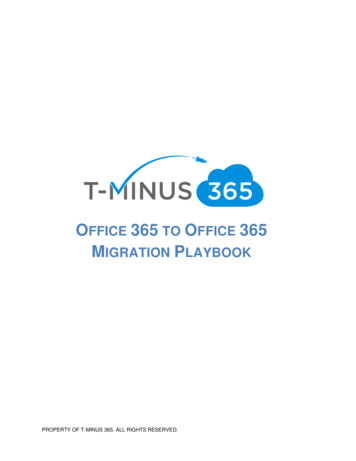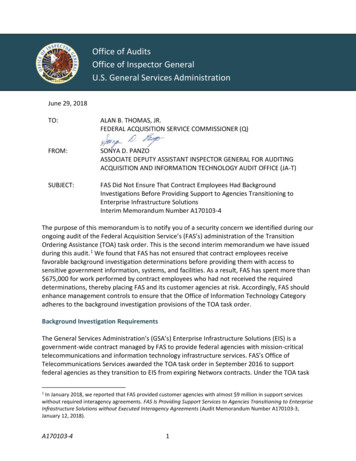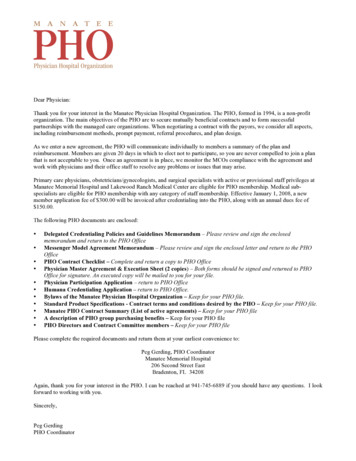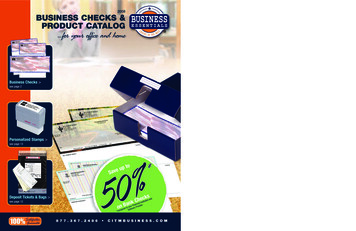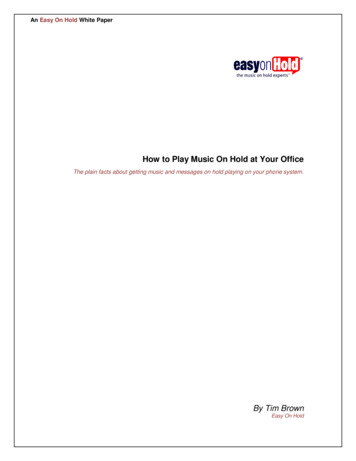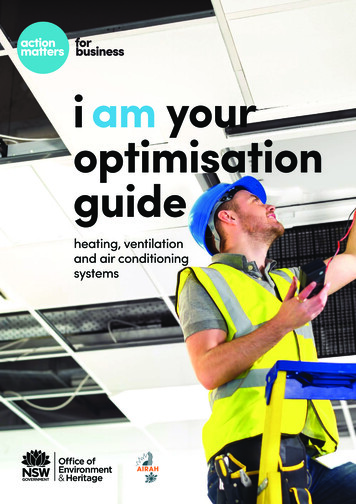
Transcription
i am youroptimisationguideheating, ventilationand air conditioningsystems
The Office of Environment and Heritage (OEH) has compiled this document in good faith, exercising alldue care and attention. No representation is made about the accuracy, completeness or suitability of theinformation in this publication for any particular purpose. OEH shall not be liable for any damage whichmay occur to any person or organisation taking action or not on the basis of this publication. Readersshould seek appropriate advice when applying the information to their specific needs.Published by:Office of Environment and Heritage59 Goulburn Street, Sydney NSW 2000PO Box A290, Sydney South NSW 1232Phone: (02) 9995 5000 (switchboard)Phone: 131 555 (environment information and publications requests)Phone: 1300 361 967 (national parks, general environmental enquiries, and publications requests)Fax: (02) 9995 5999TTY users: phone 133 677, then ask for 131 555Speak and listen users: phone 1300 555 727, then ask for 131 555Email: info@environment.nsw.gov.auWebsite: www.environment.nsw.gov.auReport pollution and environmental incidentsEnvironment Line: 131 555 (NSW only) or info@environment.nsw.gov.auSee also www.environment.nsw.gov.auPhotos: OEH, AIRAH, ThinkStock & iStockISBN 978 1 74359 990 1OEH 2015/0317July 2015
ForewordThis publication has been developed through an industry–government partnership between theNSW Office of Environment and Heritage’s (OEH) Energy Efficient Business (EEB) team and theAustralian Institute of Refrigeration, Airconditioning and Heating (AIRAH).It aims to support the adoption of energy-efficiency initiatives in NSW businesses and bringstogether expertise from both organisations and across industry.OEH’s EEB team provides assistance to NSW businesses to reduce their energy consumptionand costs, while enhancing productivity. The team has developed a suite of technology guideslike this publication. These guides, which include resources on lighting, industrial refrigeration andcogeneration, are available free to download from the OEH website: www.environment.nsw.gov.au/business.AIRAH is an independent, specialist, not-for-profit technical organisation providing leadership inthe heating, ventilation, air conditioning and refrigeration (HVAC&R) sector through collaboration,engagement and professional development. AIRAH’s mission is to lead, promote, represent andsupport the HVAC and related services industry and membership. AIRAH produces a variety ofpublications, communications and training programs aimed at championing the highest of industrystandards. AIRAH encourages world’s best practice within the industry and has forged a reputationfor developing the competency and skills of industry practitioners at all levels.This publication would not have been possible without input from the following contributors – VinceAherne (AIRAH), Mark Henderson (SEiD), Jon Clarke (Norman, Disney and Young), John Penny(Viscon Systems), Paul Bannister (Energy Action/Exergy), Lasath Lecamwasam (EngineeredSolutions for Building Sustainability), PC Thomas (Team Catalyst), Andrew Smith (A.G. CoombsAdvisory), Alex Koncar (Greenkon Engineering), Steve Hennessy (WT Sustainability) and PatrickRiakos (OEH).DisclaimerHVAC systems are complex and the extent of actual or potential energy savings will vary greatlyfrom one HVAC system to another.The examples and energy-savings potential discussed in this guide are not intended asspecifications for implementation, nor should they be considered to provide instruction on how tocomplete measurement and verification calculations for the NSW Energy Savings Scheme.It is advisable to employ specialist engineering support when developing a business case for anyof the energy-efficiency opportunities outlined in this guide. OEH has a panel of specialists who willbe able to assist with any optimisation project.Visit ncy-expert.htm.Optimising your heating, ventilation and air conditioning systemsi
ContentsForewordiList of acronymsivSection 1 – Introduction1How to use this guide2Your key optimisation opportunities3The role of HVAC controls in reducing energy use6Where is energy wasted?7How to approach optimisation8Implementation10Potential savings11Simple payback period11Section 2 – System supervisory control optimisations12Opportunity 1 — Optimum start/stop programming13Opportunity 2 — Space temperature set points and control bands18Opportunity 3 — Master air handling unit supply air temperature signal24Opportunity 4 — Staging of chillers and compressors29Section 3 – Plant control parameter optimisations34Opportunity 5 — Duct static pressure reset35Opportunity 6 — Temperature reset – resetting heating hot water delivery temperature40Opportunity 7 — Temperature reset – resetting chilled water delivery temperature40Opportunity 8 — Temperature reset – resetting condenser water delivery temperature40Opportunity 9 — Retrofit of electronic expansion valves45Section 4 – Ventilation and air flow optimisationsii48Opportunity 10 — Economy cycle49Opportunity 11 — Night purge54Opportunity 12 — DCV – based on controlling CO2 for occupied spaces59Opportunity 13 — DCV – based on controlling CO for carparks and loading docks59Office of Environment and Heritage
Section 5 – Variable speed based optimisations66Opportunity 14 — Optimised secondary chilled water pumping(differential pressure reset)67Opportunity 15 — Variable head pressure control (air-cooled condensers)71Opportunity 16 — Variable head pressure control (water-cooled condensers)74Other variable speed applications for HVAC77Integrating multiple HVAC variable speed drive controllers79Section 6 – Best practice HVAC operation and maintenance80Opportunity 17 — Energy management planning81Opportunity 18 — Energy management training and awareness86Opportunity 19 — Energy efficiency maintenance88Opportunity 20 — Management of system control software93Section 7 – Other HVAC optimisation opportunities95Optimising existing fan/pump distribution systems96Rebalancing distribution systems97Duct leakage99Optimising boilers99Demand response100Occupancy control100Free cooling100Section 8 – Maintaining your HVAC optimisationMaintaining the benefits of your optimisation101102Appendix A: Main areas of energy waste104Appendix B: Documents and resources105Appendix C: HVAC optimisation and the NSW Energy Savings Scheme107Appendix D: Explaining the fan (and pump) affinity laws109Optimising your heating, ventilation and air conditioning systemsiii
List of acronymsThe abbreviations and acronyms used in this guide have the following meaning:AC – air conditioningACP accredited certificate providerAHU – air handling unitAIRAH – Australian Institute of Refrigeration, Airconditioning and HeatingBMS – building management systemCAV – constant air volumeCHW – chilled waterCO – carbon monoxideCO2 – carbon dioxideCW – condenser waterDCV demand control ventilationDDC – direct digital controlDSPR duct static pressure resetDX – direct expansionEC electronically commutatedEDH – electric duct heaterEEV – electronic expansion valveESC – Energy Savings CertificateESS – Energy Savings SchemeFCU – fan coil unitsFTS fixed time scheduleGHG – greenhouse gasHHW – heating hot waterHLI high level interfaceHVAC – heating, ventilation and air conditioningHVAC&R – heating, ventilation, air conditioning and refrigerationHW – hot waterIAQ – indoor air qualityIPART Independent Pricing and Regulatory TribunalivOffice of Environment and Heritage
KPI – key performance indicatorM&V – measurement and verificationMBM Metered Baseline MethodsNABERS National Australian Built Environment Rating SystemNCC – National Construction CodeNGA – National Greenhouse AccountsNOX nitrogen oxideO/A – outdoor airOEH – Office of Environment and Heritage (NSW)O&M – operations and maintenanceOSS – optimum start/stopP – proportional controlPI – proportional integral controlPID – proportional integral derivative controlPIAM&V – Project Impact Assessment with Measurement & VerificationR/A – return airRESA – Recognised Energy Savings ActivitiesRH – relative humidityS/A – supply airSCHW– secondary chilled waterSMART specific, measurable, attainable, realistic and timelyTXV – thermostatic expansion valveVAV – variable air volumeVFD – variable frequency driveVSD – variable speed driveWB wet bulbOptimising your heating, ventilation and air conditioning systemsv
viOffice of Environment and Heritage
oneIntroductionHeating, ventilation and air conditioning (HVAC) contributes significantly to business energy useand operating costs, typically consuming the largest proportion of energy in commercial buildings.In a commercial building, HVAC electricity consumption can typically account for around 40 percent of total building consumption and around 70 per cent of base building electricity consumption(DCCEE Guide to Best Practice Maintenance & Operation of HVAC Systems for Energy Efficiency).Unlike other more costly energy-efficiency strategies such as plant upgrades, improving theperformance of HVAC via control systems (i.e. optimisation or building tuning) can provideimmediate reductions in energy use and energy costs. The returns on investment are often able tobe measured in months, not years and additional benefits can include: enhanced occupant comfort improved reliability of systems reduced ongoing maintenance costs improved building performance, as recognised in rating schemes such as National AustralianBuilt Environment Rating System (NABERS) and Green Star.Optimisation of controls is a cost-effective way to improve the efficiency and performance ofHVAC systems, both in older and modern buildings. This guide has been compiled to assist thoseinvolved in facilities management, building operation and systems maintenance.Optimising your heating, ventilation and air conditioning systems1
This guide outlines 20 HVAC optimisation strategies and how they can be applied. Thesestrategies can save up to 50 per cent of total HVAC energy use, or up to 80 per cent of energyuse in individual HVAC components.HVAC optimisation is sometimes as simple as changing control algorithms, altering controlschedules and set points, and carrying out minor mechanical repairs and alterations to existingequipment and systems.To achieve the benefits of optimised controls, it is essential for building owners and facilitymanagers to see optimisation as an investment rather than a cost, while directing buildingoperators and service providers to include controls optimisation within their responsibilities and keyperformance indicators (KPIs).Energy savings unlocked by HVAC optimisation activities can potentially generate revenue usingthe NSW Energy Savings Scheme. By undertaking measurement and verification, savings can bedemonstrated and Energy Saving Certificates (ESCs) can be generated and sold to offset the costsof the optimisation or to facilitate future energy-efficiency interventions.Unlike other more costly energy-efficiency strategiessuch as plant upgrades, improving the performance ofHVAC via control systems can provide immediatereductions in your energy use and energy costs.How to use this guideThe guide discusses technical concepts involved in optimising HVAC systems. It is intendedto assist all those involved in the running of these systems to plan and manage energy-savingopportunities.Energy Management ConsultantsTechnical Service Providers Improve your understanding of energy-efficiency opportunities for various types of HVAC systems. Improve value of service delivery to clients and cost-effectiveness of energy-efficiency recommendations.Building OwnersBuilding Managers Improve your understanding of potentially cost-effective energy-efficiency opportunities for your building’sHVAC system. Inform improvements to your HVAC maintenance scope of work to ensure ongoing energy efficiency.Facility ManagersSustainability ManagersBuilding Operators Use as a toolkit for improved operation of HVAC systems. Inform improvements to your HVAC maintenance scope of work to ensure ongoing energy efficiency. Make a stronger case to building owners for investment in HVAC energy efficiency.2Office of Environment and Heritage
Table 1 on the following page lists the 20 HVAC optimisation strategies that represent energysaving opportunities. Guidelines are provided for optimising the control parameters within eachstrategy. The information provided on each strategy includes: a summary of the optimisation strategy an outline of the principle and equipment involved a description of current practices that may suit a particular opportunity for optimisation an indication of the energy-saving potential and other benefits, costs and risks notes on the application and implementation of the optimisation.While the guide refers to the optimisation of existing HVAC systems, the underlying control andmanagement logic also applies to new or replacement systems. For a list of documents referencedand additional resources relevant to HVAC optimisation, refer to Appendix B.Your key optimisation opportunitiesTable 1 summarises the key optimisation strategies and provides guidance for their applicationfor different types of HVAC systems. The energy-savings potential is specific to each strategy andnon-cumulative; however, the identified energy-savings potential will naturally be greater with theadoption of two or more of these strategies.Optimising your heating, ventilation and air conditioning systems3
4Office of Environment and HeritageYYYYUp to 20% of total energyconsumed by HVAC servicesUp to 15% of total energyconsumed by HVAC servicesUp to 10% of energyconsumed by chillersUp to 30% of energyconsumed by fans servingAHUsUp to 5% of energyconsumed by HW heatersUp to 15% of energyconsumed by chillersUp to 15% of energyconsumed by chillersUp to 15% of energyconsumed by retrofitted ACcompressorsU
Optimising your heating, ventilation and air conditioning systems i. Foreword. This publication has been developed through an industry–government partnership between the NSW Office of Environment and Heritage’s (OEH) Energy Efficient Business (EEB) team and the . Australian Institute of Refrigeration, Airconditioning and Heating (AIRAH). It aims to support the adoption of energy-efficiency .
